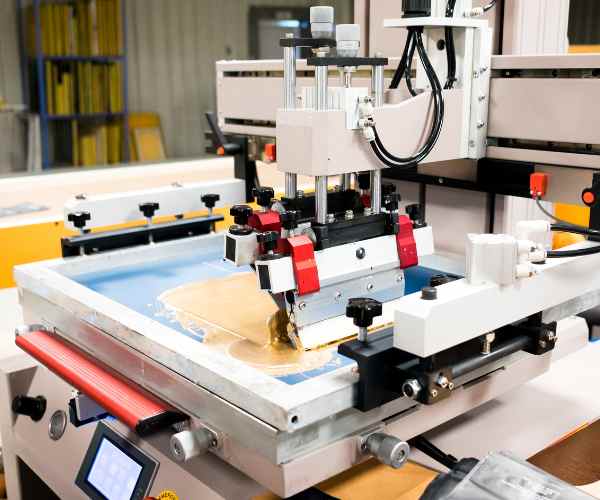Nowadays when we think about screen printing, we think about gorgeous vibrant t-Shirts, stunning posters prints and one of a kind wall art. But did you know that the development of this technique is indicative of some larger shifts in art, technology, and industry? It is intriguing to think about how this procedure which began as a relatively simple trade has over many centuries progressed into a key player in segments such as fashion, marketing, and many others.
I still remember my first encounter with screen printing – it was in an art fair that was held in our local community centre. There were people at booths painting with garments, and pulling ink across the screens, creating multiple incredible innovative styles that were absolutely unique. The place was alive, full of laughter where the air smelled fresh paint. I do remember thinking how it was such a relevant craft as it touches our lives in so many ways. It is more than just making tangible goods; it is about crafting narratives or conveying messages allowing for people connections.
Over the years, screen printing has evolved significantly. In each technological evolution, it has transformed, increasing its scope and influence. Today, it occupies a pivotal position in not only the garment and advertising industries but also in the art and culture industry. Join me on this journey through history and the importance of screen printing, in which a simple craft helped change the world.

The Roots of Screen Printing
What is screen printing?
So, what exactly is screen printing? Basically, it is a process that allows you to manually or mechanically apply ink onto a surface using a template, or as it is more commonly known, a stencil. This method makes it possible to have many colors and details on an image, hence it is widely used on clothes, art and many other things.
To visualize it better, consider a silk screen which is made taut on the frame, several areas you want to print, that is the design areas are left blank while the areas that you don’t want to print are opaque. The mesh is then pressed against the material and ink is forced through the mesh making a bold print. This is as simple as it gets but the results can be mind blowing, and people have been using this for ages.
Meanwhile, let’s go back in time a bit, shall we? The first use of silk screen can be dated back to China during the Song Dynasty, approximately 960 AD to be more precise. The Chinese artisans would simply take silk and use it as a net to create templates which would then be used to print images onto fabric. Just imagine how time helped to automate this tedious task! Then it was taken to Japan and other parts of Asia and the technique was improved over time.
**Techniques and Uses Used Early on:**
First artisans were much inventive in relation to screen printing techniques for textiles and decorative arts. For example, screen printing evolved into fine katakana printing in Japan, thesis fashions used to produce printed textiles that bore pictorial decorations. Such beautiful artwork went hand in hand with functionality and served as cultural and historical representations.
William Morris is among the key persons in terms of the impact of screen-printing techniques during the 19th century. He was a noted designer and supervised the Arts and Crafts Movement and embraced the use of screen printing methods in garb including wallpaper and plenty other textiles including practical items. He inscribed life in the ordinary setting what seems to be brilliant for such a period.
It’s amazing that considering in what forms scree printing gets today and what it used to be for example in its early days. Cloth and other products made by hand gives way to production techniques that are awe inspiring in their creativity. Trends in the expansion of screen printing will show us how this craft adjusted to the modification of technology, culture, and industry and the worlds outer structure.
The Industrial Revolution and Its Impact
Mechanization Of Silk-Screen Printing
The industrial revolution was a period in time that brought about drastic changes in various fields, including screen printing, which previously was a craft that took many hours to create as skilled artisans took their time. But when the world moved to mechanized factories, the entire printing landscape changed quite dramatically.
This advance in mechanization allowed for the speedier and quicker design of Stitch You silk screen printing machines where once multiple persons had to work in order to design a piece of cloth. Instead, thousands of pieces of printed fabric could now be produced all in a single span of time, for instance textile printing machines were able to produce thousands of textiles at a single time all from those factories in England. This rapid advancement in creating new fabric with unique and trendy designs allowed consumers to interact with fashion and art in a revolutionary manner.
On my visit to the historical textile factory, I came across some of the oldest machines used in this industry and I must say, they looked like massive beasts that were always roaring. After hearing the guides explain how the operators were trained to operate the machines and how the lives of these people drastically changed, it dawned upon me how these people were the first to use screen printing and how this information helped in building the industry.
The Beginning of Modern Screen Printing
As the twentieth century began, innovative screen printing technology began to emerge. Thanks to a number of groundbreaking developments accomplished during this time the process began to evolve. The most important event in this sequence was the advent of photoemulsion techniques. This technology enabled designs to reach a new level of detail and precision, which in turn created a world of new opportunities for both artists and manufacturers.
To make stencils, photo emulsion employs light-sensitive chemicals onto screens. This was a game changer! Now, fabric could be embedded with stunningly accurate photographs and other intricate designs. I remember attending this workshop a few years ago where photo emulsion was being used. My intrigue grew as I watched one screen after another carefully being modified to display a colored canvas. It is quite a sight to behold! Art and technology together.
The current day screen printing solutions were built on what was once modern screen printing and it found so many applications outside of fabric. From art to advertising, the potential was limitless.
The Era of Technology Transformation
Technological Advancements
Life in the current digital era is extremely fast pace, fast enough to transform the industry of screen printing entirely. Companies have begun the switch and that has led to a improvement in quality. Spending more time in one single project is no longer the industry standard. Instead, the introduction of this new technology led to improved custom turns, allowing brands to keep up with customers and the market not only instantly but consistently.
TeeSpring and Printful have been one of the few companies who have adapted the use of technology to their business, allowing for the ability to provide on demand printing services. This means that the customer himself can create a design for a shirt, a hoodie, or any other product, and such a product will only be printed once it is ordered. It’s never been so easy to minimize waste and individualize. I’ve even used these services to create t-shirts with my own designs for family reunions and they were quite fun! The ability to create something and have it made without the hassle of leftover stock was a true revolution.
Impact On The Environment
With the technological advancements in screen printing, there has also been a growing awareness towards environmental issues. In recent years there has been a greater focus on environmentally friendly techniques in the industry. There are a number of companies that have switched to water soluble inks, organic fabrics and have moved to more environmentally friendly forms of production.
For example, EcoImprints is a great company which does screen printing in an environmentally friendly way. All of their products are made using 100% organic cotton and eco-friendly inks. I was quite shocked to learn about their initiatives to cut down on waste and be more responsible. It certainly shows how the screen printing market is changing in order to comply with contemporary ecological requirements which in large is shifting culture to be more eco friendly.
In today’s world, we are given more control over our spending. We are able to pick products from a brand that seems to resonate with us the most, turning our shopping experience into a meaningful one.
Global Market Status of Screen Printing Today
Trends in Screen Printing
Screen printing has seen unprecedented shifts and growth in recent times, and trends today highlight demand for unique products, one-size-fits-all is no longer an option. The consumers drive is influencing businesses to provide an array of sizes and colors to select from, targeting them to feel unique. A key highlight of the growth of printing is the rise in custom print orders, which further compliments the trend of on demand production of goods.
Furthermore, screen printing has taken off thanks to social media. Artists and businesses apart from showcasing their end products also share their creations and skills on platforms like Instagram and Tiktok. The space is now filled creativity, and I personally found some cool artists with a plethora of high quality works that don’t run out of ideas to make new ones. The whole space has now noticeably more vibrant due to the practice of screen printing enhanced imagination and a collaborative approach.
Success Stories
The screen printing business has roofed some of the most inspiring success stories in today’s world. One of those is custom ink. It started off as a small business of custom T shirt printing but now has been transformed into one of the big players in the market. It offers a platform through which people and organizations can easily create and order custom apparel. This is a remarkable example of how by fusing creativity with technology and excellent customer service success can be achieved.
Threadless is yet another incredible admirable story, an e-commerce site that runs on community and allows artists to upload their T shirt designs and lets other community members vote on it. The submitted designs with the most votes are then printed and sold. This authority to vote has made a lot of designers empowered and gave an opportunity for new and original art to be monetized. I support independent artists and buy from this website so that they can succeed so I often check out their website for gifts.
The stories reveal how the screen printing continues to grow and flourish in this fast pacing world. It is the best time for professionals in this industry and I wonder what it would turn into!
Frequently Asked Questions
Is screen printing different from other printing techniques?
Typically, screen printing, digital printing, and vinyl printing falls under a triad of categories with each of them possessing their own set of merits and demerits. Let us analyze these in the following manner:
The technique or model of printing that is screen printing is similar to the traditional ‘Squid Game’ character who has a paint brush in his hand it follows the same pattern. A stencil or a screen is made for every color that a design has incorporating pigment which in turn is pressed against a piece of clothing. The method greatly compliments bulk orders of diverse sizes because the outcome is always bright and captivating. As a result, vibrant colors that stand out are simple to create.
On the other hand, digital printing is the advanced germ that exists in the world of printing practices. It employs the use of computer-generated files to transfer ink directly onto objects, similar to how printers function in the house. Due to this technique, very small quantities are printed economically and with the addition of design, there is a lot of detail. I once used it for bespoke T-shirts, where we printed a family picture, and the quality was incredible!
Vinyl printing is, however, the specialty printing that all professional shirtists are familiar with as such which is available in the market and not all of them.
The technique utilizes heat to apply vinyl which is cut into shapes. It can fit any type of garment since it provides durability, making it perfect for sports jerseys. While vinyl is a great option if you want to be absolutely sure about your design lasting, remember that vinyl may be harder to work with.
If you need to reproduce an image or logo in color and on a large scale, then screen printing is the most appropriate option. If wanting to print highly detailed images and in small quantities, utilizing digital printing is the best option. If creating something long lasting, then vinyl is the most reliable option! Each process has its appeal, but it is best to decide based on what you want to produce.
How do I get started with screen printing as a hobby?
To those who would want to start in screen printing, I can tell you that it is an amazing journey and an amazing process! Here’s how to get started: Gather Your Supplies: You need a few items to set up a screen printing business. These are a screen, slide, emulsion, ink, and a light for exposing your design. Do not worry; there are starter kits available which help beginners very much! Choose a Design: Don’t go for too much complex design. You can choose or design something for yourself. One of the greatest advantages of screen printing is that you are able to creativity. I remember I started with a simple rectangular design, and I loved the way it turned out on the clothing.
Calibrating the Emulsion for a Screen: After you are satisfied with your design, proceed to applying emulsion on your screen and then expose it to light following the directions provided. This particular step is quite important because this will serve as your stencil. Don’t hurry, make sure you get it properly done!
Do A Lot of Repetition: If the initial prints are not up to the mark do not be discouraged. The initial prints that I made were quite al over the place but the experience I have today I owe it to that! Every print is an opportunity to get better.
Share the Best Printing Group: Participate in online discussions, attend regional classes, and browse the social networking scene. When it comes to screen printing, everyone is helpful and I have made quite a few friends who teach me what they know. And it is even better when you can show someone how well you have done!
Don’t take it too seriously!: Above all, have fun! It is experimentation in screen printing that allows you to portray yourself. Every print allows an individual to produce something more beautiful than the last.
Who can get benefitted through screen printing services Industries?
Whenever we talk or think about multiple industries, and possibilities within them, spanning across multiples verticals and domains, a method stands out for each, now that method is called screen printing, check out some industries that can make use of screen printing, in the list below – Fashion And Apparel Industry: Now this industry is in huge demand and undergoing rapid evolution, custom apparel and tailoring is now within everyone’s reach and is a go to branding strategy for many businesses, clothing lines can use screen printing and designers can rely on this technique to resolve and create bold graphics and a wide array of complex patterns. Advertising: In today’s world, businesses heavily rely on screen printing for promotional events, and for that perfect B2B and B2C communication, make use of banners and signage, that is where screen printed material comes in, with the combination of vibrant colors and durability, all of these materials are properly made and stand the test of time, providing businesses with an effective means of communication . Arts: Designing artworks, revamping old ones, or simply making custom structures, artists can resort to screen printing as their medium to re create posters or even limited edition artworks , for those who want to take their artwork to the next level, this technique is perfect, as it brings out colors and textures most other methods can’t achieve, allowing the final piece to stand out. Textiles: If we dig into specific aspects of the textile industry, then purchasing bed linens, or curtains of screen printed and decorated fabrics would be in the boom as businesses would thrive for them, screen printing is one of the methods used in this industry. Sports: Now through sports uniforms, we can make use of screen printing to put logos and names of athletic/ sporting businesses on uniforms, this leads to more businesses since clothing brands will purchase sport uniforms to advertise them during events. Packaging: Labels, Stickers and Packaging designs are other things that businesses will get done through screen printing as doing it, assist them in improving the transportation of those designs while being durable and reliable. Overall, with so many use cases, one clear advantage of being in multiple industries is the increase in screen printing’s role, be it in modern production or being of importance
Conclusion
In conclusion, it’s safe to say that this craft has developed tremendously from its ancient version as we head towards the end of our journey of exploration with the screen printing crafts.
The progress from artisan occupation to such a significant element in multiple industries is in many ways fantastic.
It captures deeper shifts in art, technology and culture by demonstrating how the concept of being creative can be modified over time.
Eco-consciousness fully assists screen printing as one of the main components in the artwork.
If you’re an artist, if you own a business or if you just appreciate this artistic form, I would like to advise strongly that you engage further with screen printing.
Make sure to look at the materials from a different perspective, not solely the end products but the continuum aspects that go into the picture, as well.
Who knows? Perhaps, you may find the desire for screen printing that begins your creative pathway!






